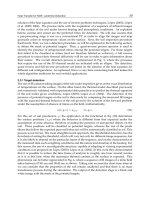Developments in Heat Transfer Part 8 docx
Bạn đang xem bản rút gọn của tài liệu. Xem và tải ngay bản đầy đủ của tài liệu tại đây (2.11 MB, 40 trang )
expression for the minimum attainable value for the product
1/2 *
*
AE
under the given
Reynolds number.
4.5 Concluding remarks
As exemplified by the water-water counter-flow heat exchanger, the present work shows
that there exists an optimal duct aspect ratio for heat exchangers under the fixed Reynolds
number and mass velocity when the entransy dissipation number is taken as the
performance evaluation criterion. Furthermore, the formula for the optimal duct aspect ratio
was obtained analytically. Under constraints of the fixed heat transfer area (or duct volume)
and Reynolds number, it was shown that there is an optimal dimensionless mass velocity;
for which an analytical expression was also given. The results indicated that to reduce
irreversible dissipations in heat exchangers, largest-possible heat transfer areas and lowest-
possible mass velocities should be adopted. This conclusion is in agreement with numerical
results obtained by design optimization of the shell-and-tube heat exchanger based on the
entransy dissipation number as the objective function (Guo et al., 2010).
From the results obtained in this study, it can be seen that the traditional heat exchanger
design optimizations based on total cost as an objective function usually sacrifice heat
exchanger performance. This issue has been demonstrated by numerical results (Guo et al.,
2009). Guo et al. (2009) found that a little improvement in heat exchanger performance can
lead to large gains in terms of energy saving and environmental protection. Hence, in heat
exchanger design, reduction in total cost and improvement in heat exchanger performance
should be treated equally. The present work will be useful to drive new research in this
direction.
5. Acknowledgements
The support of our research by National Basic Research Program of China (Project No.
2007CB206900) is greatly appreciated.
6. References
Bejan, A. (1982). Entropy Generation through Heat and Fluid Flow. New York, Wiley
Bejan, A. (1988). Advanced Engineering Thermodynamics. New York, Wiley
Bejan, A. (1995). Entropy Generation Minimization. New York, CRC Press
Bejan, A. (1996). Entropy generation minimization: the new thermodynamics of finite-size
devices and finite-time processes. J Appl Phys, Vol. 79, pp.1191-1218
Ben-Amotz, D. & Honig, J. M. (2006). Average entropy dissipation in irreversible
mesoscopic processes. Phys Rev Lett, Vol. 96, pp. 020602.
Ben-Amotz, D. & Honig, J. M. (2003). Rectification of thermodynamic inequalities. J Chem
Phys, Vol.118, pp. 5932.
Bertola, V. & Cafaro, E. (2008). A critical analysis of the minimum entropy production
theorem and its application to heat and fluid flow. Int J Heat Mass Transfer, Vol. 51,
pp.1907-1912.
Bizarro, J. P. S. (2008). Entropy production in irreversible processes with friction. Phys Rev E,
Vol. 78, pp. 021137
Chen, L.; Wei, S. & Sun, F. (2011). Constructal entransy dissipation rate minimization of a
disc. Int J Heat Mass Transfer, Vol. 54, pp. 210.
Chen, Q. & Ren, J. X. (2008). Generalized thermal resistance for convective heat transfer and
its relation to entransy dissipation. Chinese Science Bulletin, Vol. 53, pp. 3753-3761
Cheng, X. & Liang, X. (2011). Entransy flux of thermal radiation and its application to
enclosures with opaque surfaces. Int J Heat Mass Transfer, Vol. 54, pp.269.
Cheng, X. G. (2004). Entransy and its Application in Heat Transfer Optimization. PhD thesis,
Tsinghua University, Beijing
Clausius, R. (1865). The Mechanical Theory of Heat-With its Applications to the Steam
Engine and to Physical Properties of Bodies. London: John van Voorst, 1
Paternoster Row, MDCCCLXVII.
den Broek, C. V. (2005). Thermodynamic efficiency at maximum power. Phys Rev Lett, Vol.
95, pp.190602.
Esposito, M. & Lindenberg, K. (2009). Universality of efficiency at maximum power. Phys
Rev Lett, Vol.102, pp.130602.
Esposito, M. et al. (2010). Efficiency at maximum power of low-dissipation Carnot engines.
Phys Rev Lett, Vol. 105, pp. 150603.
Guo, J. F.; Cheng, L. & Xu, M. T. (2009a). Entransy dissipation number and its application to
heat exchanger performance evaluation. Chinese Sci Bull, Vol. 54, pp. 2708.
Guo, J. F.; Xu, M. T. & Cheng, L. (2009b). The application of field synergy number in
shell-and-tube heat exchanger optimization design. Appl Energ, Vol. 86, pp.
2079-2087
Guo, J. F.; Li, M. X. & Xu M. T. (2010). The application of entransy dissipation theory in
optimization design of heat exchanger, Proceedings of the 14
th
International Heat
Transfer Conference, IHTC14-23348, Washington, DC, USA, August 8-13, 2010
Guo, Z. Y.; Zhu, H. Y. & Liang, X. G. (2007). Entransy-A physical quantity describing heat
transfer ability. Int J Heat Mass Transfer, Vol. 50, pp. 2545.
Guo, Z. Y. et al. (2010). Effectiveness-thermal resistance method for heat exchanger design
and analysis. Int J Heat Mass Transfer, Vol. 53, pp. 2877.
Hesselgreaves, J. E. (2000). Rationalisation of second law analysis of heat exchanger. Int. J.
Heat Mass Transfer, Vol. 43, pp. 4189-4204
Herwig, H. (2010). The Role of Entropy Generation in Momentum and Heat Transfer,
Proceedings of the 14
th
International Heat Transfer Conference, IHTC14-23348,
Washington, DC, USA, August 8-13, 2010
Jaynes, E. T. (1980). The minimum entropy production principle. Annu Rev Phys Chem, Vol.
31, pp. 579-601
Kondepudi, D & Prigogine, I. (1998). Modern Thermodynamics-From Heat Engines to Dissipative
Structures, John Wiley & Sons, Chichester
Landauer R. (1975). Inadequacy of entropy and entropy derivatives in characterizing the
steady state. Phys Rev A, Vol. 12, pp.636-630
Li, X. F.; Guo, J. F., Xu, M. T. & Cheng, L. (2011). Entransy dissipation minimization for
optimization of heat exchanger design. Chinese Sci. Bull. (Accepted)
Liu, X. B.; Meng, J. A. & Guo, Z. Y. (2009). Entropy generation extremum and entransy
dissipation extremum for heat exchanger optimization. Chinese Science Bulletin, Vol.
54, pp. 943-947
Mamedov, M. M. (2003). On the incorrectness of the traditional proof of the principle of
minimum production. Technical Physics Letters, Vol. 29, pp. 69-71
McClintock, F. A. (1951). The design of heat exchangers for minimum irreversibility. ASME
Paper, No. 51-A-108, 1951, presented at the 1951 ASME Annual Meeting
Prigogine, I. (1967). Introduction to Thermodynamics of Irreversible Processes, Third ed., Wiley,
New York, pp. 76-77.
Shah, R. K. & Skiepko, T. (2004). Entropy generation extrema and their relationship with
heat exchanger effectiveness-number of transfer unit behavior for complex flow
arrangement. ASME J Heat Transfer, Vol. 126, pp. 994.
Wang, S. P.; Chen, Q. L. & Zhang, B. J. (2009). An equation of entransy transfer and its
application, Chinese science bulletin, Vol.54, pp. 3572-3578.
Wu, J. & Liang, X. G. (2008). Application of entransy dissipation extremum principle in
radiative heat transfer optimization. Science in China Series E: Technological Sciences,
Vol. 51, pp. 1306-1314
Xia, S. J.; Chen, L. G. & Sun, F. R. (2009). Optimization for entransy dissipation minimizatino
in heat exchanger. Chinese Science Bulletin, Vol.54, pp. 3587-3595
Xu, M. T. & Cheng L. (2010). From the extremum principle of entransy dissipation to
steady balance equations of fluid mechanics, Proceedings of the 14
th
International
Heat Transfer Conference, IHTC14-23348, Washington, DC, USA, August 8-13,
2010
Xu, M. T.; Guo, J. F. & Chen, L. (2009). Application of entransy dissipation theory in heat
convection. Front. Energy Power Eng China, Vol.3, pp. 402-405
Xu, M. T. (2011). The thermodynamic basis of entransy and entransy dissipation. Energy,
Vol. 36, 4272-4277
Yilmaz, M.; Sara, O. N. & Karsli, S. (2001). Performance Evaluation Criteria for Heat
Exchangers Based on Second Law Analysis. Exergy, an International Journal, Vol.1,
pp. 278-294.
Ziman, J. M. (1956). The general variational principle of transport theory. Can J Phys, Vol. 34,
pp.1256-1273
15
Inverse Space Marching Method for
Determining Temperature and Stress
Distributions in Pressure Components
Jan Taler
1
, Bohdan Węglowski
1
,
Tomasz Sobota
1
, Magdalena Jaremkiewicz
1
and
Dawid Taler
2
1
Cracow University of Technology
2
University of Science and Technology
Poland
1. Introduction
Thermal stresses can limit the heating and cooling rates of temperature changes. The largest
absolute value of thermal stresses appears at the inner surface. Direct measurements of these
stresses are very difficult to take, since the inner surface is in contact with water or steam
under high pressure. For that reason, thermal stresses are calculated in an indirect way
based on measured temperatures at selected points, located on an outer thermally insulated
surface of a pressure element. First, time-space temperature distribution in pressure element
is determined using the inverse space marching method.
High thermal stresses often occur in partially filled horizontal vessels. During operation
under transient conditions, for example, during power plant start-up and shut-down, there
are significant temperature differences over the circumference of the horizontal pressure
vessels (Fetköter et al., 2001; Rop, 2010). This phenomenon is caused by the different heat
transfer coefficients in the water and steam spaces. This takes place in large steam generator
drums, superheater headers and steam pipelines. High thermal stresses caused by
nonuniform temperature distribution on vessel circumference also occur in emergency
situations such as fire of partially filled fuel tanks. The upper part of the horizontal vessel is
heated much faster than the lower part filled with liquid.
Similar phenomenon occurs in inlet nozzles in PWR nuclear reactor, at which high
temperature differences on the circumference of the feed water nozzles are observed.
The study presents an analysis of transient temperature and stress distribution in a
cylindrical pressure component during start-up of the steam boiler and shut-down
operations. Thermal stresses are determined indirectly on the basis of measured
temperature values at selected points on the outer surface of a pressure element. Having
determined transient temperature distribution in the entire component, thermal stresses are
determined using the finite element method. Measured pressure changes are used to
calculate pressure caused stresses. The calculated temperature histories were compared with
the experimental data at selected interior points.
The presented method of thermal stress control was applied in a few large conventional
power plants. It can also be used successfully in nuclear power plants. The developed
method for monitoring thermal stresses and pressure-caused stresses is also suitable for
Developments in Heat Transfer
274
nuclear power plants, since it does not require drilling holes for sensors in pressure element
walls. Measurements conducted over the last few years in power plants demonstrate that
the presented method of stress monitoring can be applied in systems for automatic power
boiler start-up operations and in systems for monitoring the fatigue and creep usage factor
of pressure components.
2. Present methods used to determine temperature and thermal stress
transient in boiler pressure elements
The simplest and most frequently used method for reducing thermal stresses in pressure
elements is to limit heating and cooling rates. The allowable rates of fluid temperature
changes can be determined using German Boiler Codes TRD 301 (TRD 301, 2001) or
European Standard EN 12952-3 (EN 12952-3, 2001). The allowable heating rate of temperature
changes is determined from the following condition (EN 12952-3, 2001; TRD 301, 2001)
(
)
2
min
2
om
T
mTwf
ppd
vs
sa
ααφφσ
−
+=
. (1)
The maximum allowable cooling rate is calculated in a similar way:
(
)
2
max
2
om
T
mTwf
ppd
vs
sa
ααφφσ
−
+=
. (2)
In Equations (1-2), the following nomenclature is used: α = k/(c·ρ) – thermal diffusivity,
m
2
/s, r
in
, r
out
– inner and outer radius, m, d
m
= r
out
+ r
in
– mean diameter, m, p – absolute
pressure, MPa, p
o
– ambient pressure, MPa, s = r
out
- r
in
– thickness of cylindrical element, m,
v
T
– rate of temperature changes of fluid or pressure element wall, K/s, α
m
– pressure
caused stress intensity factor, α
T
– thermal stress intensity factor, σ
min
– allowable stress
during start-up (heating), MPa, σ
max
– allowable stress during shutdown (cooling), MPa.
Coefficients
φ
w
and
φ
f
are defined as follows
1
w
E
β
φ
ν
=
−
, (3)
(
)
(
)
()
()
22 4
2
2
31 14ln
811
f
uu uu
uu
φ
−−−
=
−−
, (4)
where: E – Young's modulus, MPa, β – linear coefficient of thermal expansion, 1/K,
ν
– Poisson’s ratio, u = r
out
/r
in
– ratio of outer to inner surface radius.
Equations (1-2) can also be used to calculate the maximum total stress at hole edges. The
heating or cooling rate of temperature changes in pressure elements v
T
can be calculated
using the moving average filter (Taler, 1995)
(
)
43 2 1
01234
1
63 42 117 162
693
177 162 117 42 63 ,
i
Tiiii
tt
iiii
df
vffff
dt t
ff f f f
−− − −
=
++++
== −++ + +
Δ
++ + + −
(5)
where f
i
are medium or wall temperatures at nine successive time points with Δt time step.
Inverse Space Marching Method for Determining
Temperature and Stress Distributions in Pressure Components
275
Equations (1-2) and (5) are not only valid for a quasi-steady state (Taler, 1995), but also
when the temperature change rate v
T
is the function of time: v
T
= v
T
(t). For pressure
components with complex geometry, the stress value in the stress concentration areas can be
calculated using the finite element method (FEM). By determining the so called influence
function with the use of the FEM, one is subsequently able to carry out an on-line stress
calculation with known heat transfer coefficient and fluid temperature transient (Taler et al.,
2002).
This chapter formulates the problem of determining the transient temperature in a pressure
element as an inverse transient heat conduction problem. The temperature distribution is
determined on the basis of temperature histories measured at selected points at the outer
insulated surface of a pressure component. After determining transient temperature
distribution in the entire pressure component, thermal stresses are computed using the
FEM. Inverse problem is solved using the finite volume method (FVM). Thermal and
pressure caused stresses are calculated using the FEM.
3. Mathematical formulation of inverse problem
In the following, two dimensional inverse heat conduction problem (IHCP) will be solved
(Fig. 1). The analyzed domain is divided into two subdomains: direct and inverse. Boundary
and initial conditions are known for the direct region so that the transient temperature
distribution is obtained for the solution of the boundary-initial problem. The temperature
distribution on the inner closed surface S
m
which is located inside the analyzed area (Fig. 1)
is known from measurements. Based on the solution of the direct problem the heat flux on
the boundary S
m
can be evaluated. Thus, the two boundary conditions are known on the
surface S
m
:
(
)
(
)
,,
m
S
Tst fst= , (6)
()
,
m
S
T
k
q
st
n
∂
−=
∂
, (7)
while on the inner surface S
in
of the body, the temperature and heat flux are unknown.
In order to evaluate the transient temperature distribution in the inverse region, this region
is divided into control volumes (Fig. 2). The method marches in space towards the inner
surface of the body S by using the energy balance equations for the finite volumes placed on
the boundary S
m
to determine the temperatures in adjacent nodes. In this way of proceeding
the time derivatives of the measured temperature changes have to be calculated. The
accurate calculation of the time derivatives of the measured temperature histories is difficult
since the measured temperature values are burdened with random measurement errors.
Thus, time-temperature charts have to be smoothed before evaluating the time derivative. In
the present section this was achieved by using the local polynomial approximation. The
successive nine temperature data points were approximated using the polynomial of the
3rd degree and then the derivatives in the middle of each interval (time coordinate of the
point 5) were calculated.
The space-marching method will be illustrated by an example showing the evaluation of the
temperature distribution in the cylindrical wall using the temperature measurement points
Developments in Heat Transfer
276
equally distributed on the surface S
m
(Fig. 2). It is assumed that the temperature and heat
flux distributions are known on the surface S
m
from temperature measurements at points 16-
22 and from the solution of the direct problem.
Fig. 1. The analyzed body divided into the inverse and direct regions
Fig. 2. Division of the inverse region into control volumes
Inverse Space Marching Method for Determining
Temperature and Stress Distributions in Pressure Components
277
For the ideally insulated outer surface the heat fluxes q
16
-q
22
and their time derivatives are
equal to zero. The heat balance equation for the finite volume with the node (i, j) is as
follows (Fig. 3):
()()
()( )
()( ) ()()
()
22
,
,, ,,
,1,
1, ,
,
,1, ,1,
1, , , 1 ,
,
,
,1 ,
1
22 2
22
22 2
ij
ij ij ij ij
ij i j
ij ij
ij
ij i j ij ij
i j ij ij ij
ij
ij
ij i
dT
rr
rr cTT
dt
kT kT
TT
r
r
r
kT kT kT kT
TT TT
r
rr
rr
kT kT
r
ϕρ
ϕ
ϕ
ϕ
+
+
−+
−+
−
⎡⎤
ΔΔ
⎛⎞⎛⎞
+−− Δ =
⎢⎥
⎜⎟⎜⎟
⎝⎠⎝⎠
⎢⎥
⎣⎦
+
−
Δ
⎛⎞
=+Δ +
⎜⎟
Δ
⎝⎠
++
−−
Δ
⎛⎞
+−Δ +Δ +
⎜⎟
ΔΔ
⎝⎠
+
+Δ
()
,1 ,
,
,
2
j
ij ij
ij
TT
r
ϕ
−
−
Δ
(8)
where: c – specific heat, J/(kg·K), ρ – density, kg/m
3
, k – thermal conductivity, W/(m·K),
t – time, s, T – temperature, °C, Δr – space step in radial direction, m, Δφ – angular step, rad.
Transforming the heat balance Equation (8) for T
i-1,j
, we obtain:
()()
()( )
()( )
()( )
()
()
()()
()( )
22
,,
,,
,
1, ,
,1,
,
2
,
,1, ,1,
,1 ,
1, ,
2
,
,1, ,1,
,,
22
2
2
22
ij ij
ij ij
ij
ij ij
ij i j
ij
ij
ij i j ij ij
ij ij
ij ij
ij
ij i j ij i j
ij ij
rr
rr
cT T
dT
TTr
r
dt
kT kT
r
r
r
kT kT kT kT
TT
r
TT
rr
r
kT kT kT kT
rr
ρ
ϕ
−
−
++
+
+
−−
ΔΔ
⎛⎞⎛⎞
+−−
⎜⎟⎜⎟
⎝⎠⎝⎠
=+Δ ⋅ ⋅ −
Δ
+
−
Δ
+
++
−
Δ
−⋅ ⋅−−⋅ ⋅
ΔΔ
Δ
++
−−
()
()()
()( )
2
,1 ,
,1 ,
2
,
,1,
,
.
2
ij ij
ij ij
ij
ij i j
ij
kT kT
TT
r
r
r
kT kT
r
ϕ
−
−
−
−
+
−
Δ
−⋅ ⋅
Δ
Δ
+
−
(9)
Since Eq. (9) is nonlinear, the fixed-point iterative technique is used to determine the
temperature T
i,j
−
1
:
()
()()
()
()
(
)
()( )
()
()
(
)
()
()
()()
()
()
(
)
22
,,
,,
,
1
,
1,
,
1,
,
2
,
,1, ,1,
,1 ,
1, ,
2
,
,,
1, 1,
,,
22
2
2
22
ij ij
ij ij
ij
n
ij
ij
n
ij
ij
ij
ij
ij i j ij ij
i
j
i
j
ij ij
nn
ij
ij ij
ij ij
ij ij
rr
rr
cT T
dT
TTr
r
dt
kT kT
r
r
r
kT kT kT kT
TT
r
TT
rr
r
kT kT kT kT
rr
ρ
ϕ
+
−
−
++
+
+
−−
ΔΔ
⎛⎞⎛⎞
+−−
⎜⎟⎜⎟
⎝⎠⎝⎠
=+Δ −
Δ
+
−
Δ
+
++
−
Δ
−−−
ΔΔ
Δ
++
−−
()
()()
()
()
(
)
2
,1 ,
,1 ,
2
,
,
1,
,
.
2
ij ij
ij ij
n
ij
ij
ij
ij
kT kT
TT
r
r
r
kT kT
r
ϕ
−
−
−
−
+
−
Δ
−
Δ
Δ
+
−
(10)
Developments in Heat Transfer
278
Fig. 3. Space marching in the inverse region
The iteration process continuous until the condition
() ()
1
1, 1,
nn
ij ij
TT
ε
+
−−
−
≤ is satisfied. Symbol n
denotes the iteration number and
ε is some small number (tolerance), for example, ε = 0.0001 K.
If the thermal properties are constant, the iterations are not required.
To determine the wall temperature at the node 1 (Fig. 2) we proceed as follows. First the
heat balance equations are written for the nodes 16 to 22 from which the temperature at the
nodes 9 to 13 is determined. Then the heat balance equations are set for the nodes 9 to 13
from which the temperature at the nodes 4 to 6 is evaluated. From the heat equations for the
nodes 4, 5 and 6, we can determine the temperature at node 1 located at the inner surface of
the pressure component. Based on the measured temperatures at the nodes 17 to 23, the
temperature at the node 2 is calculated in similar way. Using the measured temperature at
nodes 18 to 24 the temperature at the node 3 is estimated.
Repeating the procedure described above for all the nodes, located at the outer surface, at
which the wall temperature is measured, the temperature at the nodes situated at the inner
component surface are determined. After determining the temperature distribution at the
whole cross-section at the time point
t, the temperature distribution at time t + Δt is
computed. After calculating the temperature distribution the thermal stresses were calculating
using the FEM. The finite element mesh is constructed so that the FEM nodes are coincident
with the nodes used in the finite volume method.
Random measurement errors of the temperature
f
j
(t) have great influence on the estimated
temperature and thermal stress distributions. If the temperature data are burdened with
random errors, least squares smoothing is used to reduce the effect of the measurement
errors on the calculated time derivatives d
f
j
/dt or dT
i,j
/dt. The Gram orthogonal
polynomials were used for smoothing the measured time-temperature history
f
j
(t) and
estimated temperatures
T
i
−
1,j
(t) (Taler, 1995). For linear IHCP, when thermal properties are
temperature independent, node temperatures can be expressed in explicit form (Taler &
Zima, 1999; Taler et al., 1999). In the following subsection the linear IHCP will be presented
in detail.
Inverse Space Marching Method for Determining
Temperature and Stress Distributions in Pressure Components
279
4. Linear inverse problem
The typical way of evaluation of inverse method accuracy is to use the direct method to
generate the ”measured data” on the outer surface assuming the values of fluid temperature
and heat transfer coefficients on the inner surface. The generated data are then used as input
data for the inverse method. The results from the inverse solution are accurate when they
agree with assumptions made for the direct problem.
First, a direct problem of heat conduction, where the boundary conditions on the drum
inner and outer surfaces as well as initial conditions are known, will be discussed. Then the
temperature distribution will be determined on the basis of measured temperature changes
on the outer, thermally insulated surface of the drum with unknown boundary condition on
the inner surface (the inverse problem). The problem formulated in this way, as ill-posed, is
more difficult to solve than the first one.
Both direct and inverse problems of heat conduction allow the determination of temperature
distribution in the drum cross-section. However, the procedure for thermal stresses
determination is slightly different in the two cases. In the direct method both temperature
distribution and thermal stresses are calculated using FEM. In the inverse method, unlike
the direct problem solved by FEM, the initial and boundary conditions on the inner surface
are not set because the transient temperature distribution is obtained from temperature
measurements on the outer surface of the drum. Temperature values used for stress
calculations are obtained from the inverse solution presented in this section.
4.1 Direct problem of heat conduction
The direct problem has been solved with the following assumptions:
Temperature distribution is described by equation:
2
22
111TTT
r
rr r at
r
∂
∂∂∂
∂
∂∂
∂ϕ
⎛⎞
+=
⎜⎟
⎝⎠
(11)
with boundary conditions:
0
o
rr
T
k
r
∂
∂
=
=
, (12)
(
)
in
in
ww
rr
rr
T
khTT
r
∂
∂
=
=
=− (13)
0
≤
ϕ
≤
ϕ
w
,
(
)
in
in
ss
rr
rr
T
khTT
r
∂
∂
=
=
=− (14)
ϕ
w
≤
ϕ
≤ π,
and initial condition:
(
)
0
0
,
t
TTr
ϕ
=
= . (15)
Developments in Heat Transfer
280
The symbols h
w
and h
s
stand for heat transfer coefficients at water and steam region,
respectively. The initial temperature T
0
(r, φ) is known from measurements or calculations at
steady state.
Since the temperature field is symmetrical with respect to the vertical plane passing through
the drum longitudinal axis, the temperature field is analyzed only in half of the drum. The
division of drum cross-section into control volumes and finite elements has been shown in
Figs. 4 and 5, respectively.
Fig. 4. Division of half of drum cross section into control volumes (52 control volumes)
Fig. 5. Division of half of drum cross-section into finite elements (125 nodes, 96 elements)
The direct problem will be solved separately by means of two methods: the method of
control volume (CVM) and finite elements. The following data have been used for
Inverse Space Marching Method for Determining
Temperature and Stress Distributions in Pressure Components
281
calculations: r
in
= 0.65 m, r
out
= 0.74 m, k = 47 W/(m·K),
ρ
= 7850 kg/m
3
, c = 500 J/(kg·K),
ϕ
w
= π/2, h
w
= 1000 W/(m
2
·K) and h
s
= 2000 W/(m
2
·K). The changes of the fluid temperature
in time (T
w
= T
s
) have been shown in Fig. 6.
In the control volumes method, following planar discretization, 52 ordinary differential
equations are obtained, which have been integrated by Runge-Kutta method.
Fig. 6. Fluid temperature changes in drum as function of time and temperature at nodes on
the outer surface obtained from the solution of the direct problem using FEM; 1 – 6 numbers
of curves refer to the numbers of temperature measuring points on the drum outer surface
Fig. 7. Comparison of temperature changes at points 2 and 6 calculated by control volume
method and FEM
Developments in Heat Transfer
282
The calculation results have been presented in Fig. 6. From the comparison of temperature
changes on the inner surface at points
ϕ
2
= π/6 and
ϕ
6
= 5π/6 shown in Fig. 7 it can be seen
that the agreement of results obtained by FEM and those by means of control volumes
method is very good.
4.2 Inverse problem of heat conduction
The transient temperature distribution in the drum cross-section will be determined on
the basis of temperature measurements on the drum outer thermally insulated surface.
Thus we have to solve an inverse problem of heat conduction because there are two
known conditions on the outer surface: temperature and heat flux and none on the inner
surface.
A general inverse problem in cylindrical coordinates will be solved by means of control
volume method. A diagram of drum wall division into elementary cells has been shown in
Fig. 8a.
(a) (b)
Fig. 8. Division of drum wall into control volumes: (a) calculation pattern in inverse problem
to determine temperature at point 1 at the inner surface on the basis of temperature
measurement at five points: 9 ÷ 13 at the surface; (b) half of drum cross-section divided into
control volumes when solving the inverse problem
Temperature is determined only in three nodes in the radial direction: on the outer surface,
in the wall middle and on the inner surface. Unlike in the direct problems, so few nodes
are entirely sufficient for exact evaluation of temperature distribution (Taler & Zima, 1999).
The method has a local character because in order to determine the temperature changes at
point 1 on the inner surface it is enough to measure the temperature at five points 9 ÷ 13 on
Inverse Space Marching Method for Determining
Temperature and Stress Distributions in Pressure Components
283
the outer surface. It is assumed that besides the temperature, the heat flux is known at
points 9 ÷ 13. Nodes 9 ÷ 13 are located on easily accessible outer surface, where it is easy to
place thermocouples for temperature measurements. When surface r
5
on which the
temperature is measured is thermally insulated, then q
9
= q
10
= q
11
= q
12
= q
13
= q
14
= q
15
= 0.
Since the considered problem is inverse, it is described only by Eq. (11) and boundary
condition (12) on the outer surface. In order to determine the temperature distribution in the
whole cross-section including the inner surface the inverse space marching method is
presented. Using the control volume method the following heat balance equations for nodes
10, 11 and 12 on the outer surface are obtained:
()
22
10 9 10 4 10 11 10
54 4 10 5
55
22 2
dT T T T T T T
rr
crr k k rk
q
r
dt r r r
ϕ
ρ
ϕϕ
ϕϕ
−− −
ΔΔ Δ
−= + Δ+ −Δ
ΔΔΔ
, (16)
()
22
10 11 5 11
11 12 11
54 4 11 5
55
22 2
TT TT
dT r T T r
crr k k rk
q
r
dt r r r
ϕ
ρ
ϕϕ
ϕϕ
−−
ΔΔ−Δ
−= + Δ+ −Δ
ΔΔΔ
, (17)
()
22
612 1312
12 11 12
54 4 12 5
55
22 2
TT T T
dT T T r r
crr k k rk
q
r
dt r r r
ϕ
ρ
ϕϕ
ϕϕ
−−
Δ−Δ Δ
−= + Δ+ −Δ
ΔΔΔ
. (18)
From Eqs. (16), (17) and (18) temperatures T
4
, T
5
and T
6
are determined, respectively
(
)
()
()
22
2
54
10 5
4 10 9 10 11 10
2
44
45
2,
2
2()
rr r
r
dT r r
TT T T T q
ar dt r k
rr
ϕ
Δ−
Δ
Δ
=+ − − + +
Δ
(19)
(
)
()
()
22
2
54
5
11
511 10 1112 11
2
44
45
2,
2
2()
rr r
r
rr
dT
TT T T T
q
ar dt r k
rr
ϕ
Δ−
Δ
Δ
=+ − − + +
Δ
(20)
(
)
()
()
22
2
54
5
12
612 11 1213 12
2
44
45
2
2
2()
rr r
r
rr
dT
TT T T T
q
ar dt r k
rr
ϕ
Δ−
Δ
Δ
=+ − − + +
Δ
. (21)
Next, marching in space towards the inner surface the heat balance equation for node 5 is
written as:
()
22
54515 65115
42 2 4
33
2
dT T T T T T T T T
crr k rk rk rk r
dt r r r r
ϕ
ρ
ϕϕ
ϕϕ
−− − −
Δ
− = Δ+ Δ + Δ+ Δ
ΔΔΔ Δ
, (22)
from which temperature T
1
is determined:
()
()
()
()
2
22
5
44
142 4565 11
2
222
23
21
2
r
dT
rrr
Trr TTTT T
ar dt r r
rr
ϕ
Δ
⎛⎞
Δ
=−− −+++−
⎜⎟
Δ
⎝⎠
. (23)
After the substitution of temperatures T
4
, T
5
and T
6
defined by Equations (19), (20) and (21)
respectively to (22), we obtain after transformations:
Developments in Heat Transfer
284
(
)
()
()
(
)
(
)
()
()
()()
()
()
2
22 2222
2
42 5442
22
11 11
111 54
22
242
24
22 22
3
54 42
10
11 12
2
35
24
2
10 11
2
45 25 23
11
2
4
2
2
2
111
2
22
rr rrrrr
rdT dT
TT rr
rrradt
arr dt
rr rr
r
dT
dT dT
r r dt dt dt
ar r
r
TTT
rr rr rr
ϕ
ϕ
⎡⎤
−Δ−−
⎛⎞
Δ
⎢⎥
=+ +− + + −
⎜⎟
⎢⎥
⎝⎠
⎣⎦
⎡⎤
−−
Δ
⎛⎞
⎢⎥
−+−+−
⎜⎟
⎢⎥
⎝⎠
Δ
⎣⎦
⎛⎞
Δ
−++−+
⎜⎟
Δ
⎝⎠
()
()
()
()
()
()
()
()
12
22
5
9101112 13 101112
22
4
23 45
2
22
425
11
5
11
42 24
11
2 3 2 2
22
11
.
2
rr
rr
TT T T T q qq
rk
rr rr
rrrr
dq
rr
q
krr arrk dt
ϕϕ
+
⎡
ΔΔ ⎤
Δ
⎛⎞
⎢
+−+−+−−++
⎥
⎜⎟
⎢⎝ ⎠
ΔΔ
⎦
⎣
Δ−
⎛⎞
Δ
+++
⎜⎟
⎝⎠
(24)
In order to determine the heat flux in the node on the inner surface it is indispensable to
know the temperature at two adjacent points also on the inner surface. Assuming that the
temperatures in nodes 2 and 3 have been determined in a similar way as for node 1, we can
define the heat flux in node 2 from the equation of heat balance for this node:
()
22
32 62
212
21 2 21
11
222
TT TT
dT T T r r
crr k k k rqr
dt r r r
ϕ
ρ
ϕϕ
ϕϕ
−−
Δ−ΔΔ
−
=++Δ+Δ
ΔΔΔ
, (25)
from which a formula for heat flux is obtained:
(
)
()
()
()
22
21
62
22
2123
2
2
11
1
2
2
2
rr
TT
dT r r
qk T TT
ar dt r r
r
ϕ
⎡
⎤
−
−
Δ
⎢
⎥
=−−+−
⎢
⎥
Δ
Δ
⎣
⎦
. (26)
If the temperature of fluid T
∞
is known, also heat transfer coefficient h
2
on cell 2 border
contacting the liquid can be determined:
2
2
2
q
h
TT
∞
=
−
. (27)
Formulae (19), (20) and (24) defining the temperature in nodes and in formula (26) for heat
flux include the time derivatives of the functions representing the changes of the measured
temperatures in time. It is difficult to calculate these derivatives due to random
measurement errors.
In the present section the measured temperature histories have been smoothed by local
approximation with Gram’s polynomials (Taler, 1995; Taler & Zima, 1999). The
approximating polynomial coefficients have been determined on the basis of successive
eleven measurement points. The smoothed value of measured temperature (approximating
polynomial) and its time derivatives are determined only in the middle of the interval, i.e. in
time : t
i
+ 5(Δt), where t
i
is time coordinate of the first point in the analyzed time interval: t
i
,
t
i
+10(Δt).
Inverse Space Marching Method for Determining
Temperature and Stress Distributions in Pressure Components
285
4.3 Calculation examples-testing of inverse method
The division of the half of drum cross-section into control volumes to solve the inverse
problem has been shown in Fig. 8b.
To test the inverse method a typical procedure was applied. First the direct problem was
solved by means of control volume method, calculating the temperature changes at points
15 ÷ 21. Next the calculated temperatures were used as ”measurement data”. The inverse
problem was solved at time step Δt = 40 s, and the time changes of temperature and heat
transfer coefficient at points 1 ÷ 7 on the inner surface were determined. From the analysis of
Fig. 9 it can be seen that there is a good agreement between the temperatures obtained from
the solution of the direct problem (FEM) and those obtained from the solution of the inverse
problem. So it can be seen, that in spite of the little number of nodes in the radial direction
the inner surface temperature can be exactly determined based on the temperature
measurements on the outer surface.
Fig. 9. Comparison of temperature changes at points 2 and 6 obtained from inverse problem
solution and direct problem solved by FEM
The heat transfer coefficients determined at the same points 2 and 6 differ only slightly from
h
w
= 1000 W/(m
2
·K) and h
s
= 2000 W/(m
2
·K) taken when solving the direct problem (Fig.
10). The differences between temperatures and stresses distributions on the drum
circumference are a little larger. This is due to the small number of control volumes on the
drum circumference. Using the seven temperature measurement points on the outer surface
and assuming the step change of heat transfer coefficient from h
w
to h
s
, it is very difficult to
determine the temperature and stress distribution in the drum for
ϕ
≅ π/2. It is caused by
small temperature differences at points 1 ÷ 3 and at points 5 ÷ 7 (Fig. 4). In order to obtain
better accuracy of the inverse solution, especially at the water-steam boundary where an
abrupt change of heat transfer coefficient occurs, the grid of control volumes should be
made finer in this area.
Developments in Heat Transfer
286
Fig. 10. Comparison of heat transfer coefficients determined from solution of inverse heat
conduction problem at point 6 (h
s
= 2000 W/(m
2
·K)) and a point 2 (h
w
= 1000 W/(m
2
·K)) (see
Fig. 9): 1 and 2 – given (exact) and calculated value of heat transfer coefficient in steam
space, respectively, (point 6); 3 and 4 – given (exact) and calculated value of heat transfer
coefficient in water space, respectively, (point 2)
5. Experimental validation of the developed method
In order to validate the developed method and to improve the computer system for
continuous monitoring the power boiler operation, modern experimental installation was
built (Fig. 11). During its construction, particular emphasis was placed on ensuring that the
conditions are similar to those that may occur in pressure components installed in power
plants. In addition to metal temperature, temperature, mass flow rate, and pressure of the
steam were measured as a function of time. To measure temperature distribution on the
outer surface of the steam header pre-calibrated thermocouples were used. The
experimental installation consists of the following elements:
•
steam generation unit with steam output capacity 700 kg/h, equipped with a three-
stage oil burner,
•
installation for boiler feed water treatment,
•
tray-type (cascade-type) deaerator,
•
blow down flash-vessel for heat recovery,
•
steam pressure reduction station 10 bar /4 bar /2 bar,
•
boiler control system,
•
steam header made of martensitic high alloy P91 steel.
The measurements of temperature carried out on the outer surface of the steam header will
be used for the determination of the temperature and stress distributions at the wall cross-
section including the inner and outer surfaces of the steam header using the inverse heat
conduction methods.
Inverse Space Marching Method for Determining
Temperature and Stress Distributions in Pressure Components
287
Fig. 11. View of the experimental installation for testing the computer system for on-line
monitoring thick-wall pressure components
The steam header was made out of the martensitic high alloy P91 steel. The following
physical properties of the P91 steel have been adopted for calculations: specific heat,
c = 486 J/(kg·K), thermal conductivity, k = 29 W/(m·K), density, ρ = 7750 kg/m
3
, modulus of
elasticity, E = 2.28·10
11
Pa, Poisson’s ratio, ν = 0.29, coefficient of thermal expansion
β = 0.098·10
−
4
1/K. The outer diameter d
out
, wall thickness
δ
and the length L are: 355 mm,
50 mm and 3765 mm, respectively. Thirteen thermocouples NiCr-NiAl (K-type) were
mounted every 15° on the half of the outer circumference at the distance of 2150 mm from
the inlet of steam (Fig. 12a). The actual temperatures measured at the outer surface of the
steam header were used in the analysis. To validate the inverse technique developed in the
chapter, four thermocouples were installed at the interior locations:
δ
1
=
δ
2
= d
out
– 0.50
δ
,
δ
3
= d
out
– 0.75
δ
and
δ
4
= d
in
+ 6 mm (Fig. 12b), where the symbol
δ
denotes the tube
thickness. These measurements were carried out with sheathed thermocouples NiCr-NiAl
(K-type) with outer diameter of 3 mm. The temperatures measured at seven nodes 22-28 on
the outer surface of the steam header (Fig. 13) were used for the determination of the
temperature and stress distributions at the wall cross-section including the inner surface.
The agreement between the calculated and measured temperature values is satisfactory.
The small discrepancies are caused by the delayed and damped response of the
thermocouples.
The measured and calculated temperature histories are depicted in Figs. 14a and 14b,
respectively. The comparison of the calculated and measured temperature values at the
interior points is shown in Fig. 15.
After determining the temperature distribution the thermal stresses and stresses due to
inner pressure were calculated using the FEM. Circumferential and longitudinal stresses at
the inner and outer header surfaces as functions of time are shown in Figs. 16 and 17,
respectively.
Developments in Heat Transfer
288
(a)
(b)
Fig. 12. Location of temperature sensors on the steam header (a) thermocouples at the outer
surface on the steam header; (b) location of interior thermocouples used for experimental
validation of the inverse procedure
Inverse Space Marching Method for Determining
Temperature and Stress Distributions in Pressure Components
289
Fig. 13. Division of the steam header cross-section into finite volumes
The largest stresses (Figs. 16-18) occur at the beginning of the heating process, when the
ratio of wall temperature change is significant. The stresses at the outer surface are lower in
comparison to the inner surface. The greatest absolute value has the longitudinal stress at
the inner surface (Figs. 16-17). The influence of the inner pressure on the calculated stresses
is negligible since the inner pressure is very low (Fig. 14a).
6. Conclusions
The chapter presents a method of transient temperature field identification in the drum on
the basis of measured temperature changes at locations on the outer insulated surface of the
pressure component. The method’s accuracy was demonstrated by comparison of measured
and calculated temperature at a few internal points. In order to reduce the sensitivity of the
inverse method to random errors, the measured temperature histories were smoothed by
the moving average filter based on the Gram’s polynomials approximating nine successive
measurement points. The smoothed value of measured temperature and its time derivatives
are determined only in the middle of the interval, i.e., in time t
i
+ 4(Δt), where t
i
is time
coordinate of the first point in the analyzed time interval: [t
i
, t
i
+ 8(Δt)]. From the measured
temperature histories on the outer surface of a pressure component, the temperature
distribution can be determined at different time points in the whole cross section. Based on
nodal temperatures determined in such a way, thermal stresses are calculated using FEM.
Values of fluid temperature and heat transfer coefficient on the inner surface of the component
are not needed because the temperature distribution in the component cross-section is
determined by the developed method for solving the inverse heat conduction problem.
Thus, the developed method is more accurate than the direct temperature distribution
methods, because the fluid temperatures and heat transfer coefficients are unknown in
operating components.
Developments in Heat Transfer
290
Fig. 14. Time changes of the measured (a) and computed (b) temperature values
Fig. 15. Comparison of the calculated and measured time changes of the wall temperature at
the interior points
(a)
(b)
Inverse Space Marching Method for Determining
Temperature and Stress Distributions in Pressure Components
291
(a) (b)
Fig. 16. Circumferential stress as a function of time; (a) – inner surface, (b) – outer surface
(a) (b)
Fig. 17. Longitudinal stress as a function of time; (a) – inner surface, (b) – outer surface
(a) (b)
Fig. 18. Equivalent stress as a function of time; (a) – inner surface, (b) – outer surface
Developments in Heat Transfer
292
The method developed in the chapter can be used for the stress identification in monitoring
systems for the assessment of remnant lifetime of pressure components in conventional and
nuclear power plants.
7. References
European Standard EN 12952-3 (2001). Water-tube boilers and auxiliary installations – Part 3:
Design and calculation for pressure parts, European Committee for Standardization,
reu de Stassart, 36 B-1050 Brussels, ISBN 0-580-38354-7
Fetköter, J.M.; Lauer, D.J.; Wedemeyer, M. & Engelhard G. (2001). Replacement of
Shutdown Cooling System and Repair of Nozzle Welds of Reactor Pressure Vessel
in the Forsmark 1 + 2 Nuclear Power Plant, VGB PowerTech, Vol.81, No.6, (June
2001), pp. 62-64, ISSN 978-3-86875-347-9
Rop, P. (2010). Drum Plus: a drum type HRSG with Benson benefits. Modern Power Systems,
Vol.30, No.10, pp. 35-40, ISSN 0260-7840
Taler, J. (1995). Theory and Practice of Identification of Heat Transfer Processes, Ossolineum,
ISBN 83-04-04276-2, Wrocław-Warszawa-Kraków, Poland (in Polish)
Taler, J., Węglowski, B., Zima, W., Grądziel, S. & Zborowski, M. (1999). Analysis of Thermal
Stresses in a Boiler Drum During Start-Up, Transactions of the ASME, Journal of
Pressure Vessel Technology, Vol.121, No.1, (February 1999), pp.84-93, ISSN 0094-9930
Taler, J.; Zborowski, M. & Węglowski, B. (2002). Optimisation of Construction and Heating
of Critical Structural Components of Boiler Drums. VGB PowerTech, Vol.82, No.11,
(November 2002), pp. 19-24, ISSN 978-3-86875-347-9
Taler, J. & Zima, W. (1999). Solution of inverse heat conduction problems using control
volume approach, International Journal of Heat and Mass Transfer, Vol.42, No. 6,
(March 1999), pp. 1123-1140, ISSN 0017-9310
TRD 301 (2010). Zylinderschalen unter innerem Überdruck. Technische Regeln für
Dampfkessel (TRD), Heymanns Beuth Köln – Berlin, S. 143-185, ISBN
9783452273925
16
Experimental Prediction of Heat
Transfer Correlations in Heat Exchangers
Tomasz Sobota
Cracow University of Technology
Poland
1. Introduction
Heat exchangers is a broad term related to devices designed for exchanging heat between
two or more fluids with different temperatures. In most cases, the fluids are separated by a
heat-transfer surface. Heat exchangers can be classified in a number of ways, depending on
their construction or on how the fluids move relative to each other through the device. The
use of heat exchangers covers the following areas: the air conditioning, process, power,
petroleum, transportation, refrigeration, cryogenic, heat recovery, and other industries
applications. Common examples of heat exchangers in everyday use are air preheaters and
conditioners, automobile radiators, condensers, evaporators, and coolers. (Kuppan, 2000).
Many factors enter into the design of heat exchangers, including thermal analysis, size,
weight, structural strength, pressure drop, and cost. Cost evaluation is obviously an
optimization process dependent upon the other design parameters (Pitts & Sissom, 1998).
Economics plays a key role in the design and selection of heat exchanger equipment, and the
engineer should bear this in mind when taking up any new heat transfer design problem.
The weight and size of heat exchangers are significant parameters in the overall application
and thus may still be considered as economic variables (Holman, 2009; Shokouhmand et al.,
2008; Rennie & Raghavan, 2006).
Calculations of heat exchangers can be divided into two categories, namely, thermo-
hydraulic and mechanical design calculations. The subject of thermal and hydraulic
calculations is to determine heat-transfer rates, heat transfer area and pressure drops needed
for equipment sizing. Mechanical design calculations are concerned with detailed
equipment specifications, including stress analyses.
Heat exchanger problems may also be considering as rating or design problems. In a rating
problem, should be determined whether particular exchanger will perform a given heat-
transfer duty adequately. It is of no importance whether the exchanger physically exists or
whether it is specified only on paper. In a design problem, one must determine the
specifications for a heat exchanger that will handle a given heat-transfer duty. A rating
problem also arises when it is desired to use an existing heat exchanger in a new or
modified application (Serth, 2007). A particular application will dictate the rules that one
must follow to obtain the best design commensurate with economic considerations, size,
weight, etc. They all must bee considered in practice (Holman, 2009; Shokouhmand et al.,
2008; Rennie & Raghavan, 2006).









